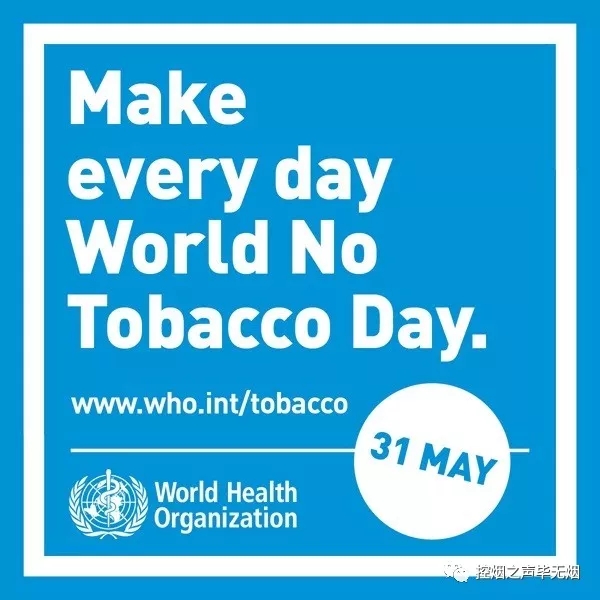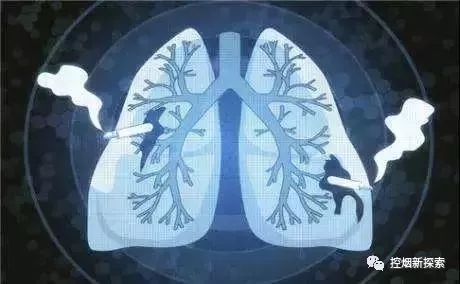阅读排行
- 日
- 周
- 月
2019年世界无烟日:烟草和肺部健康
2019年世界无烟日:烟草和肺部健康
2019年5月31日
第32个世界无烟日
——烟草和肺部健康
世界卫生组织(世卫组织)和全球合作伙伴每年于5月31日举办世界无烟日活动,借此一年一度之机促进就烟草使用和接触二手烟雾的有害和致命影响提高认识,并劝阻使用任何形式的烟草。
2019年世界无烟日的重点是“烟草和肺部健康”,旨在提高人们对以下问题的认识:
烟草对人们肺部健康的负面影响,包括从癌症到慢性呼吸系统疾病。
肺对所有人的健康与福祉起着根本作用。
该活动还可作为行动呼吁,倡导实施有效政策以减少烟草消费,并鼓励多种部门的利益攸关方参与控烟斗争.
烟草如何危害全世界人民的肺部健康
2019年世界无烟日将重点关注接触烟草影响全世界人民肺部健康的多种方式。
具体包括:
肺癌。吸烟是导致肺癌的主要原因,全球三分之二以上肺癌死亡由吸烟所致。在家中或工作场所接触二手烟雾也会增加罹患肺癌的风险。戒烟可降低肺癌风险:戒烟10年后,肺癌风险可降至吸烟者的一半左右。
慢性呼吸系统疾病。吸烟是慢性阻塞性肺病的主要原因,慢性阻塞性肺病指充满脓液的粘液在肺部积聚,导致痛苦的咳嗽和呼吸困难。由于烟草烟雾可显著减缓肺部发育,因此年轻时便开始吸烟的人罹患慢性阻塞性肺病的风险尤其高。烟草还会加剧哮喘,而哮喘会限制活动并导致残疾。尽早戒烟是减缓慢性阻塞性肺病发展和改善哮喘症状的最有效治疗方法。
影响生命全程。因母亲吸烟或母亲接触二手烟雾而在子宫内暴露于烟草烟雾毒素的婴儿,经常会出现肺部生长及功能减退的情况。接触二手烟雾的幼儿面临哮喘、肺炎和支气管炎发病及恶化的风险,并可能频繁罹患下呼吸道感染。
全球估计有16.5万名儿童因二手烟雾引起的下呼吸道感染在5岁之前死亡。能够活到成年的人则继续遭受因接触二手烟雾导致的健康后果,因为幼儿时期频繁罹患下呼吸道感染会显著增加成年后患慢性阻塞性肺病的风险。
结核病。结核病会损害肺部并降低肺功能,吸烟会进一步减弱肺功能。烟草烟雾的化学成分可引发结核病的潜伏感染,约四分之一的人患有这种感染。由吸烟造成的肺部健康损害会加重活动性结核病,由此大大增加因呼吸衰竭而致残和死亡的风险。
空气污染。烟草烟雾是一种非常危险的室内空气污染形式:它含有超过7000种化学物质,其中69种已知会导致癌症。虽然烟雾可能是看不见和无味的,但它可以在空气中徘徊长达五个小时,使那些接触者面临肺癌、慢性呼吸系统疾病和肺功能降低的风险。
2019年世界无烟日运动目标
改善肺部健康的最有效措施是减少烟草使用和对二手烟雾的接触。但是,在一些国家,普通大众,特别是在吸烟者中,对吸烟和接触二手烟雾给人们肺部健康造成的影响认识低下。尽管有确凿证据表明烟草对肺部健康造成危害,但仍然低估烟草控制对改善肺部健康的潜力。
2019年世界无烟日将在以下方面提高认识:
●吸烟和接触二手烟雾带来的风险;
●了解吸烟对肺部健康的特殊危害;
●烟草引起的全球肺部疾病死亡和患病的严重程度,包括慢性呼吸系统疾病和肺癌;
●关于吸烟与结核病死亡之间联系的新证据;
●接触二手烟雾对不同年龄组人群肺部健康的影响;
●肺部健康对实现整体健康与福祉的重要性;
●主要受众(包括公众和政府)为减少烟草对肺部健康造成的风险可采取的可行措施和行动。
烟草和肺部健康这个跨领域问题对其他全球进程(例如为促进健康而控制非传染性疾病、结核病和空气污染的国际努力)具有影响,并为各部门利益攸关方的参与提供了机会,同时使各国有能力加强实施《世界卫生组织烟草控制框架公约》中行之有效的MPOWER控烟措施。
行动呼吁
仅做到无疾病并不能实现肺部健康,烟草烟雾对全球吸烟者和非吸烟者的肺部健康具有重大影响。
为了实现可持续发展目标下关于到2030年将非传染性疾病导致的过早死亡减少三分之一的具体目标,烟草控制必须成为全球政府和社区的一个优先事项。目前,世界没有在按计划实现这一具体目标。
各国应通过全面实施《世界卫生组织烟草控制框架公约》和以最高程度采用MPOWER措施来应对烟草流行,其中包括制定、实施和执行旨在减少烟草需求的最有效的烟草控制政策。
家长和其他社区成员也应该采取措施,保护自己和孩子免受烟草造成的伤害,从而促进健康。
World No Tobacco Day
31 May 2019
Tobacco and lung health
Every year, on 31 May, the World Health Organization (WHO) and global partners celebrate World No Tobacco Day (WNTD). The annual campaign is an opportunity to raise awareness on the harmful and deadly effects of tobacco use and second-hand smoke exposure, and to discourage the use of tobacco in any form.
The focus of World No Tobacco Day 2019 is on "tobacco and lung health." The campaign will increase awareness on:
-
the negative impact that tobacco has on people’s lung health, from cancer to chronic respiratory disease,
-
the fundamental role lungs play for the health and well-being of all people.
The campaign also serves as a call to action, advocating for effective policies to reduce tobacco consumption and engaging stakeholders across multiple sectors in the fight for tobacco control.

How tobacco endangers the lung health of people worldwide
World No Tobacco Day 2019 will focus on the multiple ways that exposure to tobacco affects the health of people’s lungs worldwide.
These include:
Lung cancer. Tobacco smoking is the primary cause for lung cancer, responsible for over two thirds of lung cancer deaths globally. Second-hand smoke exposure at home or in the work place also increases risk of lung cancer. Quitting smoking can reduce the risk of lung cancer: after 10 years of quitting smoking, risk of lung cancer falls to about half that of a smoker.
Chronic respiratory disease. Tobacco smoking is the leading cause of chronic obstructive pulmonary disease (COPD), a condition where the build-up of pus-filled mucus in the lungs results in a painful cough and agonising breathing difficulties. The risk of developing COPD is particularly high among individuals who start smoking at a young age, as tobacco smoke significantly slows lung development. Tobacco also exacerbates asthma, which restricts activity and contributes to disability. Early smoking cessation is the most effective treatment for slowing the progression of COPD and improving asthma symptoms.
Across the life-course. Infants exposed in-utero to tobacco smoke toxins, through maternal smoking or maternal exposure to second-hand smoke, frequently experience reduced lung growth and function. Young children exposed to second-hand smoke are at risk of the onset and exacerbation of asthma, pneumonia and bronchitis, and frequent lower respiratory infections.
Globally, an estimated 165 000 children die before the age of 5 of lower respiratory infections caused by second-hand smoke. Those who live on into adulthood continue to suffer the health consequences of second-hand smoke exposure, as frequent lower respiratory infections in early childhood significantly increase risk of developing COPD in adulthood.
Tuberculosis. Tuberculosis (TB) damages the lungs and reduces lung function, which is further exacerbated by tobacco smoking. The chemical components of tobacco smoke can trigger latent infections of TB, which around a quarter of all people are infected with. Active TB, compounded by the damaging lung health effects of tobacco smoking, substantially increases risk of disability and death from respiratory failure.
Air pollution. Tobacco smoke is a very dangerous form of indoor air pollution: it contains over 7 000 chemicals, 69 of which are known to cause cancer.Though smoke may be invisible and odourless, it can linger in the air for up to five hours, putting those exposed at risk of lung cancer, chronic respiratory diseases, and reduced lung function.
Goals of the World No Tobacco Day 2019 campaign
The most effective measure to improve lung health is to reduce tobacco use and second-hand smoke exposure. But knowledge among large sections of the general public, and particularly among smokers, on the implications for the health of people’s lungs from tobacco smoking and second-hand smoke exposure is low in some countries. Despite strong evidence of the harms of tobacco on lung health, the potential of tobacco control for improving lung health remains underestimated.
The World No Tobacco Day 2019 campaign will raise awareness on the:
-
risks posed by tobacco smoking and second-hand smoke exposure;
-
awareness on the particular dangers of tobacco smoking to lung health;
-
magnitude of death and illness globally from lung diseases caused by tobacco, including chronic respiratory diseases and lung cancer;
-
emerging evidence on the link between tobacco smoking and tuberculosis deaths;
-
implications of second-hand exposure for lung health of people across age groups;
-
importance of lung health to achieving overall health and well-being;
-
feasible actions and measures that key audiences, including the public and governments, can take to reduce the risks to lung health posed by tobacco.
The cross-cutting theme of tobacco and lung health has implications for other global processes, such as international efforts to control noncommunicable diseases (NCDs), TB and air pollution for promoting health. It serves as an opportunity to engage stakeholders across sectors and empower countries to strengthen the implementation of the proven MPOWER tobacco control measures contained in the WHO Framework Convention for Tobacco Control (WHO FCTC).
Call to action
Lung health is not achieved merely through the absence of disease, and tobacco smoke has major implications for the lung health of smokers and non-smokers globally.
In order to achieve the Sustainable Development Goal (SDG) target of a one-third reduction in NCD premature mortality by 2030, tobacco control must be a priority for governments and communities worldwide. Currently, the world is not on track to meeting this target.
Countries should respond to the tobacco epidemic through full implementation of the WHO FCTC and by adopting the MPOWER measures at the highest level of achievement, which involves developing, implementing, and enforcing the most effective tobacco control policies aimed at reducing the demand for tobacco.
Parents and other members of the community should also take measures to promote their own health, and that of their children, by protecting them from the harms caused by tobacco.




